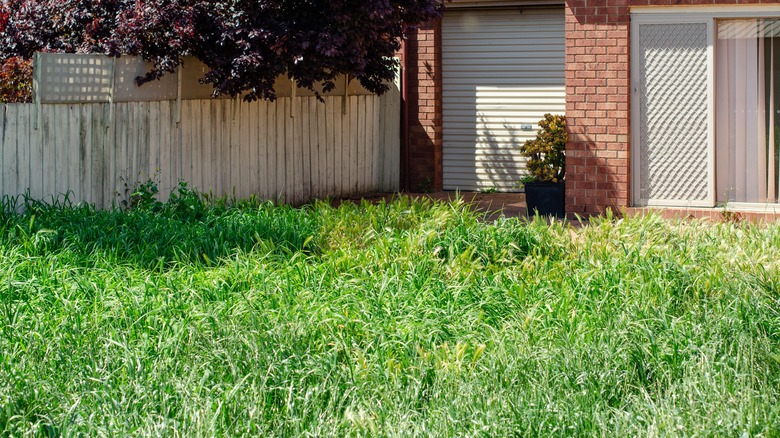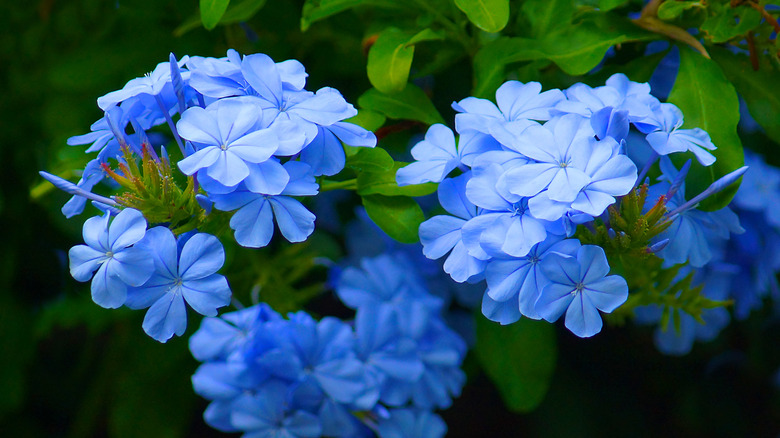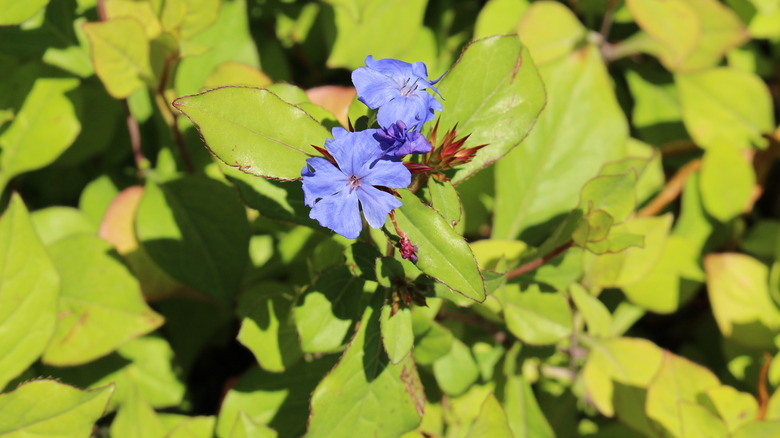The Blue-Flowering Plant That'll Help Keep Weeds Out Of The Garden
Weed control is a time-consuming affair that often involves using chemical herbicides, but did you know that there is a straightforward way to suppress weeds in your yard that's toxin-free and doesn't leave you with an aching back? That's right — by planting a ground cover shrub like plumbago (Ceratostigma larpentiae), you'll banish weeds from the garden without resorting to commercial herbicides or weeding by hand. Better yet, plumbago plants will grace the space with delicate blue blooms and vibrant foliage — all with little effort.
Plumbago is a herbaceous perennial that hails from China and thrives in USDA Zones 5a to 9b. It combats weeds in two ways. First, like any ground cover variety, plumbago starves weed seedlings of light and nutrients, so they die before getting the chance to establish themselves and spread. But crucially, plumbago releases chemical compounds that treat the surrounding soil as a natural herbicide, in a process known as allelopathy. When some nearby plants are exposed to these toxins, they can suffer from stunted growth and may even die. Below, we walk you through the advantages of using Ceratostigma larpentiae as a natural weed suppressor, explain a few drawbacks of the method, and spell out the care instructions so you can keep the plants healthy.
Pros and cons of using plumbago for weed suppression
Ground cover plants like plumbago afford a chemical-free way of keeping your yard weed-free, that's also less labor-intensive than manual weeding. However, fighting weeds with ground cover plants has its pros and cons — you should understand these before growing plumbago in your yard. Let's start with the pros. Apart from potentially making chemical herbicides unnecessary, plumbago adds an aesthetic component to the landscaping design. Whether they're in bloom or not, these shrubs adorn the garden with thickly growing, rich verdant foliage that turns deep, dark red in the fall. What's more, plumbago's roots effectively control erosion if you are gardening on a sloped yard. Finally, this low-maintenance ground cover plant is super easy to grow.
However, there are a few drawbacks to using plumbago as a weed suppressant. Firstly, plumbago spreads aggressively — this means that it can encroach on space you've set aside for other plants. Secondly, its allelopathic properties may harm other plants in your garden if they're growing nearby. Thirdly, ground cover plants like plumbago provide a perfect hiding spot for snakes and other critters. The final factor you should be mindful of is that all parts of the plumbago plant can cause dermatitis upon skin contact, so you'll always need to wear gloves when handling this shrub and educate your children about its irritant properties.
How to plant and care for plumbago in your yard
If you've decided to plant plumbago in your yard, start by finding it a suitable spot. You can plant it in rocky locations, along hillsides for the added bonus of erosion control, or elsewhere in the yard where ground cover works as a landscaping feature. Next, choose a location that gets full sun but offers a shady respite in the afternoon. Fully shaded spots won't work for plumbago. This plant can tolerate an array of soil conditions — even clay — as long as proper drainage is ensured. Likewise, soil acidity does not matter too much, and pH levels ranging between slightly acidic to a bit alkaline are fine. That said, plumbago does its best in loamy, sandy soils that are consistently moist.
Established plumbago doesn't need much maintenance. Rainfall should satisfy its watering needs unless there's a prolonged drought period. Likewise, deadheading is not something you need to worry about, since the flowers are self-cleaning. Plumbago will shed its leaves once the frosts set in, and new foliage will emerge well into spring of next year. If you're in a colder climate, mulch the plants before cold weather sweeps in — this will protect the roots. Pruning is not necessary, but you can cut the plants back as needed to accommodate the landscape design.


